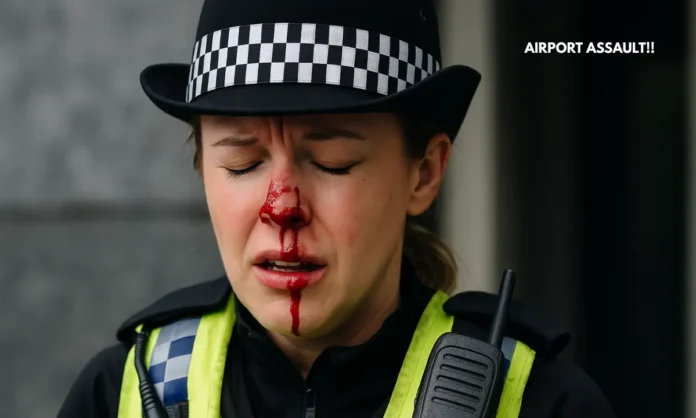Summary
- PC Lydia Ward says she was “absolutely terrified” after being punched in the face while arresting a suspect.
- Incident escalated rapidly at Manchester Airport Terminal 2, resulting in her broken nose and injuries to other officers.
- Brothers Mohammed Fahir Amaaz and Muhammad Amaad deny assaulting police officers and claim self-defence.
“I Thought He’d Broken My Face”: A Violent Night at Manchester Airport
The testimony was gut-wrenching. A police officer, trained to de-escalate situations and uphold public safety, found herself floored by a sudden, brutal punch to the face. PC Lydia Ward, a petite officer with Greater Manchester Police, told a Liverpool Crown Court jury how a routine arrest spiralled into a violent confrontation that left her injured, bloodied, and shaken. The incident, which unfolded on July 23, 2023, at Manchester Airport’s Terminal 2, has once again raised troubling questions about policing, public intervention—or lack thereof—and the thin line between self-defence and assault.
What began as a routine response to a reported headbutting incident at a Starbucks café soon became chaotic. Officers attempted to arrest 20-year-old Mohammed Fahir Amaaz at a ticket machine when he reportedly resisted. His brother, 26-year-old Muhammad Amaad, then allegedly intervened. What followed, prosecutors say, was a violent escalation: one officer pushed, another kicked, and PC Ward punched so hard her police radio battery was knocked out.
Bloodied female police officer sobs after 'being punched at Manchester Airport'.
— Dubhghall (@macnahgalla) July 10, 2025
These vile bastards need jailed for life, I wonder what they have actually been charged with? https://t.co/k5Ng3A40ne via @MailOnline
A Night of Chaos, Captured on Camera
- CCTV and bodycam footage show the incident unfold in seconds.
- PC Ward says she blacked out after being hit in the face.
- Police claim they had no time to announce themselves before the violence began.
PC Ward described the scene vividly in court: Amaaz resisting arrest, his brother entering the fray, and officers struggling to contain the situation. She tried to restrain the younger brother when, she says, he kicked her colleague and then “turned and punched me straight in the face.” She hit the floor, everything went black, and when she came to, blood was gushing from her nose.
The defence has argued that Amaaz believed he was being attacked and acted in self-defence. However, Ward insists her uniform and presence with two other officers should have made their identity clear. “He could see I was a police officer. He could see I was a female as well,” she told the court.
In the background, chaos reigned. No bystanders intervened, despite filming the ordeal. “Everyone in that room was against us,” Ward said. “To be honest, I was terrified.”
The Legal and Social Fault Lines
- The defence argues Amaaz acted in lawful self-defence, believing he was under attack.
- Police bodycam footage showed a bloodied PC Ward crying after the assault.
- Both brothers deny all charges, including assaults on officers and a Starbucks customer.
Human rights lawyer Aamer Anwar arrived with both defendants at court, symbolising the high-profile nature of the case. Their defence hinges on the notion that the suspects believed they were being unlawfully assaulted by people who hadn’t clearly identified themselves as police.
The prosecution, however, points to the body-worn video, eyewitness accounts, and the serious injuries inflicted on the officers. “Never in my whole time in the police service had that level of violence been used on me before,” Ward testified. Her use of incapacitant spray on other advancing men further reflected the pandemonium.
This incident opens up a broader conversation about public response to police enforcement, the fragility of bystander intervention, and the limits of lawful resistance.
Blood on the Tarmac: Who Protects the Protectors?
The visuals played in court were sobering. A female officer sobbing, blood streaming down her face, consoled by colleagues after being assaulted while doing her job. The courtroom listened in silence.
The case now moves into the crucial phase of deliberation, with the jury expected to weigh bodycam evidence against claims of mistaken identity and self-defence. Regardless of the outcome, the event underscores a stark truth: law enforcement officers in Britain, often unarmed and outnumbered, walk a dangerous line between protection and exposure.
The next hearing is expected to determine whether the level of force used can legally be interpreted as self-defence—or if this was a clear-cut case of violent resistance against uniformed officers in broad daylight.


